This focus idea is explored through:
Contrasting student and scientific views
Student everyday experiences
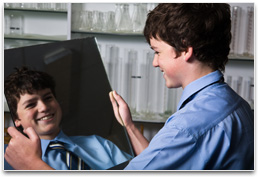 Students’ everyday experiences are in a world surrounded by natural and artificial light sources, e.g. communication and entertainment technology, living and retail spaces and city streetscapes. For a typical Australian household in 2008, nearly 30% of the household electrical energy used is for household lighting. It is rare for students to experience the total and complete darkness achievable in a photographic dark room or a deep cave.
Students’ everyday experiences are in a world surrounded by natural and artificial light sources, e.g. communication and entertainment technology, living and retail spaces and city streetscapes. For a typical Australian household in 2008, nearly 30% of the household electrical energy used is for household lighting. It is rare for students to experience the total and complete darkness achievable in a photographic dark room or a deep cave.
The everyday world of city students is now so perpetually illuminated that for them the presence of light is often taken for granted. The complete absence of light is an extraordinarily unusual experience. For most students ‘darkness’ means experiencing low levels of light rather than no light at all and so they believe their eyes will always adjust, so that even in total darkness they expect to still eventually be able to see.
Many younger students do not accept that light must be reflected from the surface of an object to their eyes for the object to be seen. Most recognise natural and artificial light sources to be emitters of light and many also believe that bright and shiny objects like mirrors are also sources of light. An important reason for this is that students’ conscious experiences of ‘reflection’ are associated with mirrors and other shiny smooth surfaces. Many believe that rough surfaces don’t reflect the light that strikes them because they are not ‘shiny’ and that light stays on the surface of these objects.
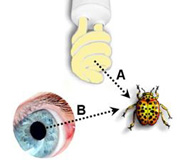 Many students hold the notion that light only needs to illuminate an object for it to be seen by their eye (represented by ray A); they do not perceive that it is necessary for light to then travel from the object to their eye. Other students believe they see objects because they actively look at them or because something comes out of their eye and travels to the object to enable them to ‘see’ it (represented by ray B).
Many students hold the notion that light only needs to illuminate an object for it to be seen by their eye (represented by ray A); they do not perceive that it is necessary for light to then travel from the object to their eye. Other students believe they see objects because they actively look at them or because something comes out of their eye and travels to the object to enable them to ‘see’ it (represented by ray B).
Some students also think that light is a property of the object or does not take time to travel from place to place, but is instantaneously everywhere.
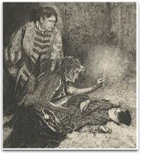 Some students also think that light is a property of the object or does not take time to travel from place to place, but is instantaneously everywhere.
Some students also think that light is a property of the object or does not take time to travel from place to place, but is instantaneously everywhere.
Many students believe that light from a luminous source travels out a certain distance and then stops. The brighter the source, the further out light travels. Many drawings of candles and fires in children’s picture books help to reinforce this idea. An example is this illustration from Walter Scott’s (1893) ‘Heart of Mid-Lothian’. Some students also believe that light travels further during the night than it does during the day.
Research:
>Osborne (1993),
Millar & Whitworth (1994),
Coates (1996), Selley (1996), Toh, Boo & Woon (1999), Tsai & Chou (2002), Skamp (2004)
Scientific view
The act of ‘seeing’ an object is the result of light from any luminous source e.g. the Sun, a glowing candle or a torch, radiating outwardly from the source until it strikes the object and is reflected to travel to the observer’s eyes where if it retains sufficient intensity it will form an image on the retina at the back of the eye to be interpreted by the brain.
Light is the narrow visible band of radiation in the broad continuous electromagnetic spectrum that ranges from radio waves to gamma rays. Its nature is complex as it transfers energy, but has no mass. It travels at very high speeds (299,800,000 m/s in the vacuum of interstellar space). It will continue travelling indefinitely until it collides with matter where it will be partly reflected and partly absorbed.
It is a requirement for vision that there be a source of light and that the light it emits either enters the eye directly (ray C in the diagram below), or it travels to an object, the beetle (ray A), where it is reflected to enter a person’s eye (ray B).
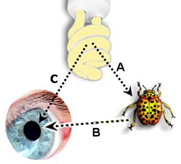 Light is so complicated that we commonly use two different models to describe its behaviour. Some experimental results support a model of light represented by lots of small
particles travelling in straight lines away from the light source in all directions. Alternately, other observed behaviour suggests that light is not composed of particles, but is best modelled by using high frequency
waves that can radiate out from the light source and interact with each other. (It is considered inappropriate at this level to introduce these models to students, even though these highlight our incomplete understanding of light.)
Light is so complicated that we commonly use two different models to describe its behaviour. Some experimental results support a model of light represented by lots of small
particles travelling in straight lines away from the light source in all directions. Alternately, other observed behaviour suggests that light is not composed of particles, but is best modelled by using high frequency
waves that can radiate out from the light source and interact with each other. (It is considered inappropriate at this level to introduce these models to students, even though these highlight our incomplete understanding of light.)
Critical teaching ideas
- Luminous objects emit light, non-luminous objects reflect and absorb light.
- Light from each point on a luminous object travels outward in all directions in straight lines.
- Light travels at very high speeds, but is not instantaneously everywhere.
- Light from luminous objects travels indefinitely until it collides with matter in its path to be partially absorbed and reflected.
- Objects are seen when light enters the eye from luminous objects or enters the eye after reflection from non-luminous objects to the eye.
 Explore the nature of light and seeing using the
Concept Development Maps – Waves and Stars.
Explore the nature of light and seeing using the
Concept Development Maps – Waves and Stars.
Teaching activities
Bring out students’ existing ideas
Try using a range of questions to probe students’ views and gain insights into their current levels of understanding about the nature and movement of light and how we see. Use or construct similar diagrams to those shown below and invent your own to explore student understandings of this specific topic.
Ask students: in your opinion, which diagram best represents the way in which we see objects like the table? Encourage students to explain their answer.
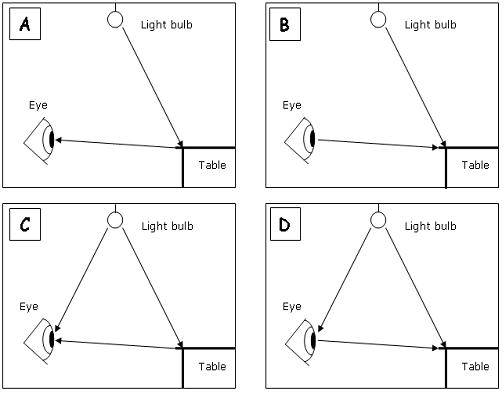
Research:
Mitchell & Keast (2002)
Challenge some existing ideas
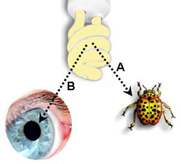 It is also common for some students to believe that to see an object light must come directly from a luminous source (ray B) to their eye while simultaneously light must strike the object we see directly (ray A) as in the diagram below.
It is also common for some students to believe that to see an object light must come directly from a luminous source (ray B) to their eye while simultaneously light must strike the object we see directly (ray A) as in the diagram below.
Variations of this idea are shown in the probe in diagrams C and D of the multiple choice question above. Students should be invited to test their ideas to determine if ray B in is really required to see the beetle. One way they can do this is to insert an obscuring screen between the source of light and their eyes to eliminate ray B.
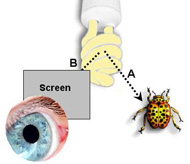 The results of this investigation will directly challenge the students’ understanding of the necessity of ray B to see the beetle, however it will not help to clarify in which direction the students believe the light must travel either to or from their eye to see the object. The diagrams C and D in the probe would assist with investigating this understanding further.
The results of this investigation will directly challenge the students’ understanding of the necessity of ray B to see the beetle, however it will not help to clarify in which direction the students believe the light must travel either to or from their eye to see the object. The diagrams C and D in the probe would assist with investigating this understanding further.
Open discussion by a shared experience
 This activity is designed to demonstrate that non-luminous objects do reflect light. It can also be used to provide further insights into the nature of coloured surfaces. It will challenge the notion that non-luminous objects do not reflect light.
This activity is designed to demonstrate that non-luminous objects do reflect light. It can also be used to provide further insights into the nature of coloured surfaces. It will challenge the notion that non-luminous objects do not reflect light.
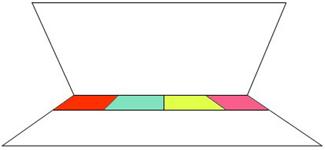 Have students construct a white page with multi coloured paper squares glued along one side as shown here.
Have students construct a white page with multi coloured paper squares glued along one side as shown here.
Students should then place the constructed page against another white page at an acute angle and view the coloured light reflecting off the second white page above the coloured squares as shown. Ask students to explain using a ray diagram the path of the reflected light from the coloured squares to their eyes.
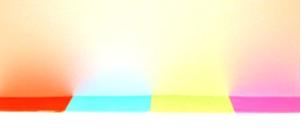 Students should be encouraged to see that the coloured light reflecting from the white page above has its origins from the coloured squares below. Light is striking the coloured squares and then reflecting to the page above where it is again reflected to their eyes. This reflection of light from the coloured squares is demonstrated by the reflected light being the same colour as the square from which the light originates.
Students should be encouraged to see that the coloured light reflecting from the white page above has its origins from the coloured squares below. Light is striking the coloured squares and then reflecting to the page above where it is again reflected to their eyes. This reflection of light from the coloured squares is demonstrated by the reflected light being the same colour as the square from which the light originates.
Challenge students’ existing ideas
Arrange to take students into a photographic darkroom to investigate if their eyes can adjust to seeing in complete darkness. It takes around 5-7 mins for a person’s eyes to become adapted to low light conditions so it is best to gradually reduce the light levels over time to a very dim source before providing students with the experience of complete darkness. If the students experience complete darkness too rapidly they may believe that their inability to see is caused by insufficient time for their eyes to adapt to the dark.
Practise using and building the perceived usefulness of scientific models
Encourage your students to look for examples of everyday situations where their views of the nature of seeing are challenged or confirmed.
How is a movie screen at the cinema different to the screen of a television or a computer monitor? The first only reflects light while the others are luminous.
Are the moon and planets which we see in the dark night sky also luminous objects? Why do we cast sharp shadows on a sunny day but produce no (or poor) shadows when it is overcast?
Research:
Mitchell & Keast (2002)